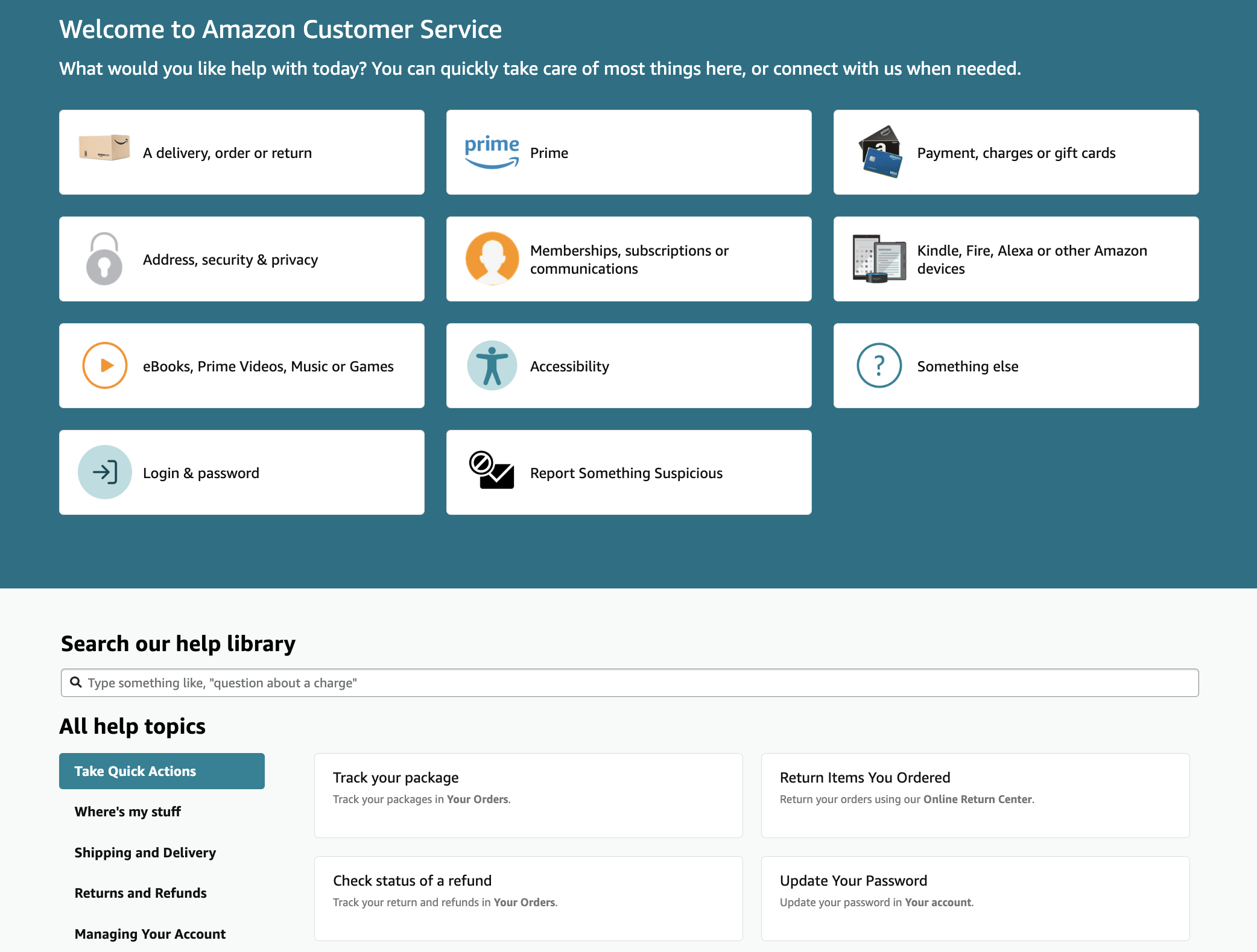Amazon is famous for its customer relationship management. Polls have ranked it as the most trusted online shopping site in America, and some have ranked Amazon Prime #1 among all loyalty programs. So how can a small ecommerce business compete with the mighty Amazon CRM strategy?
One should always learn from the best. Here’s how you can use Amazon’s methods for your own online business:
> Psst—looking for how to build a good CRM strategy as an Amazon seller instead? Read our guide to getting a great Amazon seller rating.
1. Limit the Need for Customer Service

Oft-quoted CRM strategist Brent Leary once said he’d spent 17 years shopping on Amazon and never contacted customer service.
That’s the beauty of Amazon: it runs like a dream. I made my first purchase there in 2008 and have continued to buy there since, and not once have I ever seen the website go down, had difficulty making a payment, or gotten ripped off. Neither have I ever needed to ask anyone a pre-sales question.
This smooth operation has made Amazon a marketplace that buyers come back to again and again. But how do they pull it off?
Build an Easy-to-Understand User Interface
Anyone planning to create an online store can learn from Amazon’s user interface. It’s clean, easily searchable, and easy to understand. The most important things here are:
- High-quality images
- Accurate descriptions
- Plainly visible prices and ratings
- Neatly organized categories
- A clear checkout process
Shopping on Amazon is as easy as shopping in a grocery store—and I mean a traditional one, not one of those labyrinthine co-ops clearly designed to drive customers insane. Need flour? Every type of flour we sell is in the baking goods aisle. Ready to check out? Go to the front of the store. Buying on Amazon is as easy as that.
If your grandmother would get confused trying to find and buy something on your online store, it’s too complicated. Make it as easy as possible by making sure the above bullet points describe your site. Also, see our article on building your own ecommerce website for the easiest and cheapest ways to create a store with a clean and attractive layout.
Make Self-Help Easy
Amazon has an impressive help center: you can review your orders, manage your account, read FAQs, and contact customer service, all starting from one streamlined screen. You can also search for topics if the answer to your question isn’t readily visible.
Of course, beyond this screen, Amazon has libraries full of help articles. But they have made it exceedingly simple to find what you need.
It’s the same approach they take to the products they sell: you can search for something specific or just browse a category. Clear labels and easy navigation make all the difference.
With this vast array of self-help options, Amazon makes it easy to find solutions on one’s own. This saves customers a lot of time they would have spent waiting for answers from support. And because you have to go through the self-service options to contact Amazon, customers are encouraged to find the answer first, keeping wait times down for those who need a live agent's help.
If you want to do this on your own site, there are several CRM and helpdesk platforms that allow you to create a similarly advanced help center. Onsite Support, Help Scout and Zendesk are some of our favorites (and all three can even integrate with Amazon).
2. Provide Human Support
Limiting the need for human support is wise. However, nothing is more frustrating than needing support and being unable to find a way to contact a real person.
While Amazon will try to direct you to their self-help options at first, it isn’t too hard to arrange a phone call or to contact them via email or live chat.
The amazing thing with their automated chat support is that if you jump through all the hoops, you can talk to an agent right away—and they’ll call you. That means no waiting on hold. Plus, with 24/7 support, you can get help whenever you need it.
One of the coolest innovations Amazon ever made in providing human support was Mayday for the Fire. With two taps, customers could get a live support agent on their device who could explain how to fix a problem, digitally draw on the screen to point something out, or even take over the device remotely when given permission. It was practically as good as in-person support and you didn’t even have to get off the couch.
Even more amazingly, Amazon promised to answer support calls in 15 seconds and managed an average of under 10 seconds. Mayday closed down in June 2018, but it still stands in many users' minds as an astounding example of Amazon's support capabilities.
Most small businesses can’t provide a level of support anywhere near Mayday. However, if there’s anything you can learn from the Amazon CRM strategy, it’s that giving customers a way to talk to real humans when they need to is a fantastic way to keep them loyal.
Learn how to create a customer service strategy that makes optimal use of your support agents or read up on how to provide support for your ecommerce website.
3. Communicate Challenges

When we updated this article during the COVID-19 pandemic, Amazon shoppers were experiencing all kinds of problems, including slow deliveries and refund delays of up to two weeks. Many items had become unavailable due to panic buying and Amazon's coronavirus restrictions for FBA sellers. Needless to say, it wasn't the experience customers were used to.
Amazon couldn't avoid these problems. That's why they've done the only thing they could: explain the situation to customers.
Banners across the Amazon website warned users to expect delays. Detailed articles explained the situation in depth. Existing help articles have been updated to explain what would work differently from normal—as well as what hasn't changed.
When a problem affects your service, communicate the problem to your customers. People are remarkably understanding when they know what's going on and what they should expect. They get upset fast when problems take them by surprise.
4. Create Loyalty Incentives
As mentioned at the beginning of this article, Amazon Prime is one of the world’s top loyalty programs. It features an enormous number of bonuses: faster, discounted shipping; unique and highly desirable content (TV, movie, and music streaming, Kindle book borrowing, free video games, and more); early access to deals; and even photo storage. And amazingly, they just keep adding more.
Customers have to spend about $139/year to get Amazon Prime. As a result, they need to use Amazon frequently to get their money’s worth, which motivates them to buy more from Amazon and less from competitors. The increased purchase volume gives Amazon a chance to earn back the money lost on discounts and free shipping.
Implementing some sort of loyalty program on your own site can provide you with the same advantages. If you decide to create one, learn from Amazon and provide incentives your customers really want like special discounts, free shipping, and/or highly desirable members-only content.
However, you should carefully weigh the costs against the benefits before diving in. Amazon has struggled to make any money from Prime and the same difficulties could be fatal to a small business. Decide whether the improvements to your customer relationships will be worth the potential costs.
5. Protect Your Customers

Above all, Amazon protects its customers. Third-party sellers who screw up orders get black marks against them and are required to provide refunds. And when Amazon itself makes the mistake, they immediately correct it.
One time, I ordered a keyboard that I badly needed for work. They sent it to the wrong address.
When I checked the tracking information and realized what had gone wrong, I contacted Amazon and explained my situation. They sent me a replacement right away, with expedited shipping, for exactly no money at all. They scarcely asked me a question about it.
I’ve been a loyal Amazon customer ever since.
Creating a first-class ecommerce return policy is easily the best way to imitate Amazon’s success in customer relationship management. You can bet that this devotion to making sure customers never get burned has played a huge role in making Amazon the most trusted shopping site on the web.
What Has the Amazon CRM Strategy Taught Us?
Amazon’s customer relationship management strategy is simple: make it easy to use your site, ensure your customers get their money’s worth, give them reasons to return, and provide the highest-quality and most efficient customer service you can. Do that for your customers and they will love you.
P.S. If you’re selling on Amazon and/or eBay in addition to your own ecommerce website, we can help you improve your customer service efficiency. Don’t let slow response times drag down your business!







